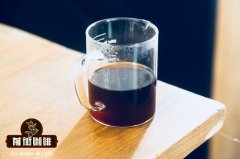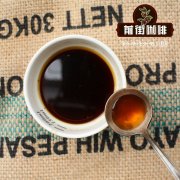The smell of coffee beans from Glinchi Kerinci Manor in Sumatra? Sumatra Glinchi coffee beans

Professional coffee knowledge exchange more coffee bean information please follow the coffee workshop (Wechat official account cafe_style)
The smell of coffee beans from Glinchi Kerinci Manor in Sumatra? The story of the grower of Glinchi coffee beans in Sumatra?
Volcanic Mount Kerinci provides a lush home for our latest single-origin Sumatra Kerinci. The surrounding mountains are the Kerinci Valley, known as the "rice bowl" of central Sumatra. Most of the 300000 people who live there depend on agriculture to support their families. Sumatra Kerinci comes from 150 small farmers working in cooperatives. In Kerinci Heights, a group of about 150 small farmers joined forces to enter the global market, get fair prices and seek sustainability on their farms. Kerinci Seblat National Park is the largest national park in Sumatra. The park's habitat is very sheltered, with more tigers than any other region in Nepal, Vietnam, Cambodia, Laos and China. This natural paradise is located on the largest volcanic slope in Indonesia and also produces some of the most precious coffee in Asia.
The coffee is produced by more than 600 farmers, who usually work less than an acre each. They are committed to improving the quality and craftsmanship of Sumatran coffee. Volcanic Mount Kerinci is a lush home where we can grow our Sumatra Kerinci at an altitude of 5000 feet.
In the traditional "Giling Basah" Sumatran process, farmers remove skin from freshly picked coffee fruits, let them ferment for a period of time, wash the beans and dry them with mucus still glued to parchment. In the stage of 40-50% moisture content, called "gabah", the coffee is then sold to the processor, dried to 25-35% moisture, and then slippery. The resulting swelling and whitening beans are called "kopi labu" or "pumpkin coffee". The final export preparation phase "Asalan" is a characteristic opal-green, containing 11-14% moisture.
Dutch settlers in the 17th century brought coffee to Indonesia. Although other Indonesian islands usually have large coffee plantations, Sumatra is mainly made up of small farmers. The Kerinci area is located on the land of volcanoes, rivers, highlands and wetlands, on the lush highlands of the Mount Kerinci Mountains near Sumatra's highest peaks (actually volcanoes).
Providing Sumatran coffee to the specialty coffee world is not a recent effort. From the 1990s to 2004, civil war raged, forcing many coffee farmers to abandon their cafes. Only after the 2004 earthquake (9.1 on the Richter scale) and the resulting tsunami can a peace agreement be signed and farmers or their widows can return to their small farms to grow coffee. Innovations in coffee processing and traceability are slowly taking place in Sumatra and will improve the lives of all those who rely on coffee as their main income.
Unique Sumatran coffee recipe with fresh cedar aromas. BlackBerry and cocoa flavors are supported by a thick, juicy body and refreshing herbs.
Region: mountain Kerinci, West Sumatra, Indonesia
Cooperative: Santiang Exports Cooperatives
Variety: Adung Sari,Sigararutang,P88,Tim Tim,Bor-Bor
Altitude: 1200-1500 m
Process: wet planing method
After picking, the farmer immediately peeled the coffee fruit.
Put the peeled beans in a woven bag or bucket and leave them overnight (with or without water).
The next day, the farmer washed off the slime and gave the coffee beans a day's rest, with some pulp still on it.
The coffee is transported to the processing warehouse.
The processor receives coffee with a water content of 40-50% and then dries to 25-35%.
The beans pass through the wet hull machine. This machine peels off the parchment and the beans are swollen and white-green.
Beans are transported to the port city for export and dried for a third time (moisture is reduced to 11-14%).
Then bag the coffee and prepare it for export.
This water content is much higher than that of coffee in most other areas. In most coffee processing methods, coffee beans are dried when leaving the processing facility until their moisture content is about 9%.
This means that coffee has a higher-than-average moisture content when bagged and exported to the destination, and this moisture has an effect on flavor.
Our Sumatran coffee comes from the Kerinci region.
This kind of coffee is grown in Mt. The Jambi area on the hillside. Kerinci . The Kerinci area is located in the lush mountain highlands near Mount Kerinci, which is the highest peak (actually a volcano) on the island of Sumatra. The area is located in the south and west of Sumatra.
Sumatran coffee beans are the heaviest, smoothest and most complex coffee in the world.
Coffee from Sumatra is most commonly processed by a method called wet shelling. Wet shelling is also known as Giling Basah processing.
The water content of coffee produced by this type of processing is much higher than that of other methods.
This is a unique process decomposition.
Wet shelling treatment:
Although there are still some experiments in coffee processing in Sumatra, the cultural and economic advantages of wet shelling will make it the dominant process in the next few years.
Characteristics of Sumatran Coffee
Those who like Sumatran's unique coffee often describe it as a simple flavor. If you are familiar with wine, it is described as terrior.
Sumatran coffee beans have very low acidity, producing aromas ranging from maple syrup to chocolate to roasted almonds.
You can expect a cup of Sumatran coffee to be smooth, full-bodied, dry and dry. You can also look forward to the unique considerations of the baker's chocolate.
Suitable for medium to deep barbecue
Because of this wet shelling process, the flavor characteristics of Sumatran coffee are very suitable for dark roasted coffee.
Low-acid coffee is ideal for people who find a mixture of stomach irritation. For example, our Sumatra Kerinci Medium Roast is actually our strongest coffee. But because the beans are of such high quality, we have ever drunk the cleanest island of Sumatra.
The nutty sweetness of Sumatran coffee makes it possible to enjoy it both at breakfast and after dinner.
Important Notice :
前街咖啡 FrontStreet Coffee has moved to new addredd:
FrontStreet Coffee Address: 315,Donghua East Road,GuangZhou
Tel:020 38364473
- Prev

Brazilian coffee characteristics the output of Brazilian coffee beans how to drink Brazilian coffee? Brazilian Santos
Professional coffee knowledge exchange more coffee bean information please follow Coffee Workshop (Wechat official account cafe_style) Brazil, the world's largest coffee producer, covers both commercial and boutique coffee, while Brazil accounts for 30 per cent of global coffee usage. In addition to the original conditions such as climate and geographical area, Brazil has created a huge national harvest today because of coffee industrialization.
- Next

What is Brazilian Santos coffee? What are the characteristics of Brazilian coffee? How do you drink Brazilian coffee?
Professional coffee knowledge exchange more coffee bean information please follow the coffee workshop (Wechat official account cafe_style) Brazil is the world's largest coffee producer accounts for about 33% of coffee production, but because Brazil is located in the tropical rain forest, the terrain is relatively flat with few high-altitude mountain forests, most coffee is grown in low-altitude non-volcanic soil areas, and there is not much shade.
Related
- Detailed explanation of Jadeite planting Land in Panamanian Jadeite Manor introduction to the grading system of Jadeite competitive bidding, Red bid, Green bid and Rose Summer
- Story of Coffee planting in Brenka region of Costa Rica Stonehenge Manor anaerobic heavy honey treatment of flavor mouth
- What's on the barrel of Blue Mountain Coffee beans?
- Can American coffee also pull flowers? How to use hot American style to pull out a good-looking pattern?
- Can you make a cold extract with coffee beans? What is the right proportion for cold-extracted coffee formula?
- Indonesian PWN Gold Mandrine Coffee Origin Features Flavor How to Chong? Mandolin coffee is American.
- A brief introduction to the flavor characteristics of Brazilian yellow bourbon coffee beans
- What is the effect of different water quality on the flavor of cold-extracted coffee? What kind of water is best for brewing coffee?
- Why do you think of Rose Summer whenever you mention Panamanian coffee?
- Introduction to the characteristics of authentic blue mountain coffee bean producing areas? What is the CIB Coffee Authority in Jamaica?

